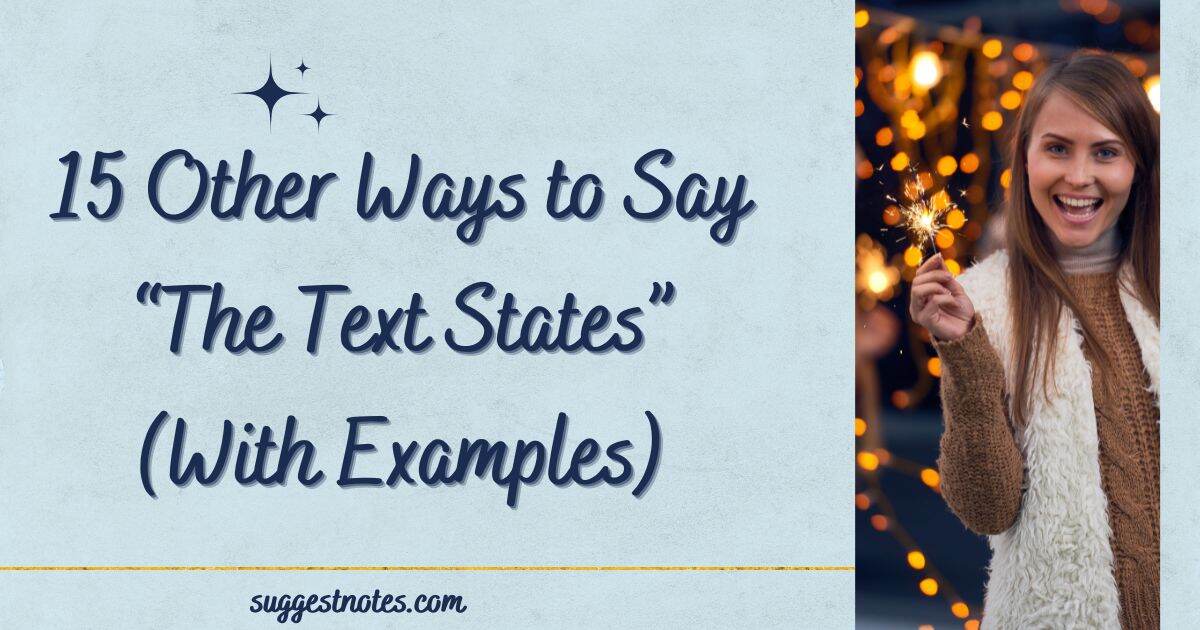Imagine a tool so effective, it turns dense information into crystal-clear insights with just three words.
“The Text States” does exactly that, transforming complex content into easily digestible key ideas that immediately grab the reader’s attention.
It’s more than just a phrase, it’s a powerful gateway that guides you straight to the heart of important details, cutting through the clutter and making sure every word counts.
Starting with “The Text States” gives your writing a compelling edge, drawing readers in and keeping them focused on what truly matters.
This straightforward approach effortlessly emphasizes main points, shares valuable insights, and presents evidence with clarity.
Whether crafting a report, article, or document, using “The Text States” ensures your message not only reaches your audience but resonates deeply.
Is It Professional to Say “the Text States”?
Yes, saying “The Text States” can be a professional choice, especially in formal writing, research papers, or legal documents.
This phrase clearly signals that you’re referencing specific information from a source, which adds credibility and precision to your writing.
It conveys a sense of authority and helps guide the reader directly to the evidence or argument being presented.
However, while “The Text States” is useful for academic or technical content, it might feel too formal in casual contexts.
To keep your writing dynamic and engaging, you can mix it up with alternatives like “the article suggests” or “the report highlights.”
This variety maintains a professional tone while adding a touch of freshness, making your writing more appealing to the reader.
Pros:
- The Text States that using this phrase helps in making content clearer and more structured, guiding readers directly to the main points.
- The Text States it adds a professional touch, making the writing sound more authoritative and credible.
Cons:
- The Text States may sometimes feel repetitive if overused, potentially making the content less engaging.
- The Text States that relying too much on this phrase might limit variety in sentence structures, reducing the writing’s overall flow.
What to Say Instead of “the text states”

- The Document Asserts
- The Passage Claims
- The Article Articulates
- The Writing Specifies
- The Section Mentions
- The Manuscript Declares
- The Narrative Describes
- The Content Reveals
- The Excerpt Indicates
- The Piece Conveys
- The Document Suggests
- The Report Illustrates
- The Analysis Explains
- The Text Highlights
- The Essay Argues
1. The Document Asserts
The Text States that using “asserts” brings a strong tone to the writing, suggesting that the content expresses its point with confidence and authority, leaving little room for doubt about the stance being taken.
Example:
The document asserts that regular physical exercise is vital not only for weight management but also for overall mental health, emphasizing the connection between physical activity and emotional well-being through various scientific studies and expert recommendations.
2. The Passage Claims
The Text States that “claims” can be used to present an argument or an opinion. This expression often indicates that the content may invite discussion or disagreement, presenting an interpretation rather than an undisputed fact.
Example:
The passage claims that high levels of caffeine consumption might contribute to anxiety disorders in some individuals, based on findings from recent research studies and the reported experiences of those who have significantly reduced their daily intake of caffeinated beverages.
3. The Article Articulates
The Text States that “articulates” is a suitable term when the content explains a concept clearly and thoroughly, often by providing specific details that help the reader understand the topic at a deeper level.
Example:
The article articulates the different stages of sleep and how each phase contributes to the body’s overall health, detailing the functions of REM sleep and deep sleep in restoring physical and mental energy during the night.
4. The Writing Specifies
The Text States that “specifies” adds a sense of clarity and precision to the information. This expression is ideal for use when the content is outlining steps, instructions, or details that must be followed accurately.
Example:
The writing specifies the steps necessary for maintaining a healthy diet, including consuming a variety of fruits and vegetables, limiting added sugars and processed foods, and ensuring an adequate daily intake of water to stay hydrated.
5. The Section Mentions
The Text States that using “mentions” is appropriate when the content touches on a subject briefly without going into much depth, often serving as a reference point for a more detailed discussion elsewhere in the document.
Example:
The section mentions the importance of work-life balance, hinting at strategies for achieving it but reserving in-depth suggestions for later in the article, where specific lifestyle changes and time management techniques are elaborated on.
6. The Manuscript Declares
The Text States that “declares” is a formal and authoritative way to present information. It suggests that the content speaks with a sense of finality, indicating a firm stance on the matter at hand.
Example:
The manuscript declares that the new law will significantly impact environmental policies nationwide, mandating strict emissions standards for all industries and setting ambitious targets for carbon footprint reductions to be achieved within the next decade.
7. The Narrative Describes
The Text States that “describes” is typically used when the content provides vivid details about a person, place, situation, or event, painting a picture in the reader’s mind through thorough explanation.
Example:
The narrative describes the ancient city, detailing its cobblestone streets lined with historic buildings, the bustling market square filled with vendors, and the old clock tower that has stood as a landmark for over five centuries.
8. The Content Reveals

The Text States that “reveals” is suitable for instances where the information uncovers or discloses something that was previously unknown or not widely understood, often bringing new insights to the reader.
Example:
The content reveals a surprising link between sleep quality and gut health, suggesting that a lack of restful sleep could disrupt the digestive system, potentially leading to various gastrointestinal issues and impacting overall wellness.
9. The Excerpt Indicates
The Text States that “indicates” is often used when the content is data-driven or suggests a conclusion that can be drawn from the facts presented, typically pointing toward evidence-based findings.
Example:
The excerpt indicates that students who participate in extracurricular activities tend to perform better academically, with data showing a significant correlation between involvement in sports or clubs and higher grades across various subjects.
10. The Piece Conveys
The Text States that “conveys” is used to communicate a particular feeling, message, or idea. It implies that the content is aimed at expressing something meaningful or important to the reader.
Example:
The piece conveys a sense of hopefulness for the future, highlighting inspiring stories of individuals who overcame adversity and how their resilience has motivated others facing similar challenges to persist despite difficulties.
11. The Document Suggests
The Text States that using “suggests” can introduce recommendations or advice within the content. It often implies that the information is intended as a proposal rather than an absolute truth.
Example:
The document suggests incorporating daily meditation as a way to reduce stress and anxiety, citing research studies that demonstrate the mental and physical health benefits of practicing mindfulness even for just a few minutes each day.
12. The Report Illustrates
The Text States that “illustrates” is ideal for content that aims to show how something works or to clarify a concept through examples, visual aids, or descriptive language.
Example:
The report illustrates the economic impact of rising fuel prices, using charts to show how increased transportation costs affect everything from food prices to manufacturing expenses, and ultimately, the overall cost of living.
13. The Analysis Explains
The Text States that “explains” should be used when the content is breaking down a complex idea into simpler terms, ensuring the reader gains a clear understanding of the subject matter.
Example:
The analysis explains the principles behind blockchain technology, detailing how transactions are recorded in a secure and decentralized manner, which prevents tampering and increases transparency in financial operations.
Related Guide:
15 Other Ways to Say “Please Let Me Know What You Think” (With Examples)
14. The Text Highlights

The Text States that “highlights” can be used to draw attention to key points, important findings, or significant parts of the content, making sure that these aspects stand out to the reader.
Example:
The text highlights the advantages of electric vehicles, noting lower fuel costs, reduced emissions, and government incentives as factors that are driving the growing popularity of this eco-friendly mode of transportation.
15. The Essay Argues
The Text States that using “argues” is appropriate when the content presents a specific viewpoint or makes a case for a particular idea, often using evidence or reasoning to support the argument.
Example:
The essay argues that remote work will become the standard for many industries in the future, suggesting that increased flexibility and productivity gains outweigh the challenges associated with managing teams from different locations.
FAQ’s
What does “The Text States” mean?
“The Text States” is a phrase used to introduce important information in written content, guiding readers to key points and clarifying the message.
How can using “The Text States” benefit my writing?
Using “The Text States” helps highlight crucial details, making the content easier to understand and ensuring that readers grasp the main ideas.
Is “The Text States” suitable for formal writing?
Yes, “The Text States” works well in formal writing, as it adds a professional tone and clearly presents essential facts or findings.
Can overusing “The Text States” affect my content’s quality?
Yes, if “The Text States” is used too frequently, it may feel repetitive and reduce the variety in sentence structure, affecting the flow.
When should I use “The Text States” in my writing?
“The Text States” is best used when you want to draw attention to specific information, making it ideal for reports, articles, and essays.
Conclusion
The Text States provides various ways to convey information effectively. By using phrases like “asserts,” “claims,” and “articulates,” writers can express their ideas with clarity and impact. Each term offers a unique perspective, helping the reader engage with the content. When writers understand how The Text States can shape their message, they enhance the overall communication.
Furthermore, employing varied expressions such as “the article conveys” or “the passage indicates” keeps the text dynamic and interesting. The Text States encourages readers to connect with the material on a deeper level. Ultimately, mastering these phrases not only enriches the writing but also makes it more accessible and enjoyable for readers.

As a content writer with five years of experience, I focus on creating insightful and impactful website content that drives engagement and boosts search visibility. With a strong foundation in SEO and digital marketing, I excel at crafting compelling narratives that resonate with audiences and enhance brand storytelling. My passion for data-driven content creation allows me to deliver pieces that not only inform but also inspire action. Whether through blog posts, web copy, or informative articles, I strive to empower businesses to connect authentically with their customers.







